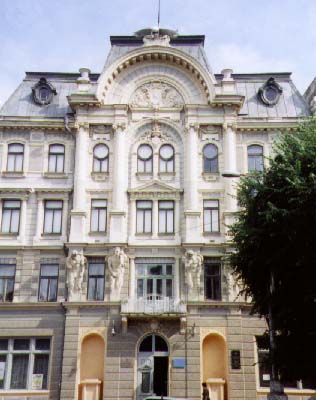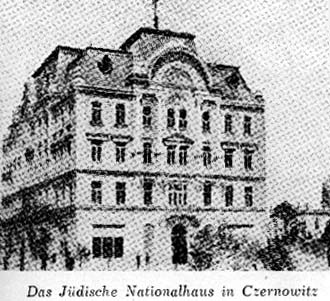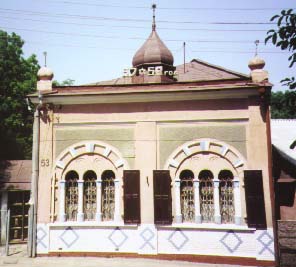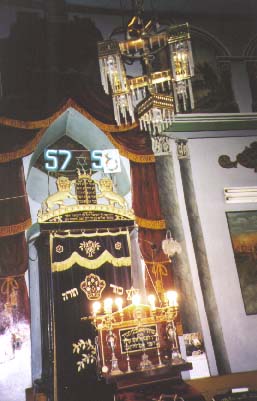The Jews of Chernivtsi
Sue Ann Harding is an Australian teacher and writer based in
Manchester, United Kingdom.
She visited Chernivtsi, Ukraine, in August 2000.
Copyright © 2001, Sue Ann Harding
First published in the Jewish Quarterly (London), Autumn 2000, Number 179.
Under the Austrian-Hungarian Empire, Czernowitz, in the foothills of the Carpathian Mountains, was a university town famous for its multicultural population, its intellectual discussions, its cafes and book shops. The pavements were swept with roses it was said, and hens scratched poetry out of the dirt. By 1919 almost half the population was Jewish. They flourished in the city’s tolerance, contributing to the community through commerce, politics, academia, music, art and literature. In 1940 there were 78 synagogues including the splendid domed and towered Reform Temple where a choir sang every week. The poorer Jews lived north of the city and spoke Yiddish. Wealthier Jews spoke German and owned shops and industries, constructing many of the elaborate buildings that characterize the city even today. This was where the shtetl met the European capital city and a marvellous synthesis was created. This was Jerusalem on the River Prut.
 |
|
Czernowitz, Bukowina, during the early 1900s.
|
Today Czernowitz is Chernivtsi, a Ukrainian provincial capital of 263 000 people who remain proud of its cultured past, its sometimes astonishing architecture and pleasant, city parks. After almost ten years of independence from the Soviet Union, much of it remains appallingly neglected and derelict, but there is evidence of reconstruction and renovation. Rows of workmen hammer new paving stones into place or climb wooden scaffolding to paint fresh pastel colours onto Hapsburg facades.
I walk the streets, searching for the legacy of the Jews of Czernowitz. White, frothy brides step out of beribboned Mercs, shaking out their skirts with a gloved hand to the accompaniment of a jovial five piece band that plays on the street corner by the sugar pink Orthodox cathedral. Wedding guests stroll up and down Kobilyanska Street, their enormous bouquets of roses limp in the heat. Youths collect in groups on park benches cracking sunflower seeds and drinking from beer bottles. Washing hangs on courtyard balconies and grape vines climb over walls. Children swim and splash in the fountain by the Taras Shevchenko memorial statue. It seems as if the Jews have vanished without trace.
 |
|
The Jewish National House in recent years.
|
But over the next few days, traces emerge. Here and there, buildings are adorned with sculptured commemorative plaques. Most celebrate Soviet and Ukrainian heroes but some recall the lives of Jewish people who lived and worked here: writers Moshe Altmann and Eliezer Steinbarg; Joseph Schmidt the famous cantor who sang in the Temple; Sidi Tal who worked in the Philharmonia; Paul Celan the poet. The Jewish plaques, I notice, were all erected within the last ten years. It is as if, in the stirring of history where Soviet and revolutionary heroes sink gently to the bottom of the pool and new bronze Ukrainian monuments and street names arise, Jewish culture is also surfacing.
The people responsible for the plaques are those of the Eliezer Steinbarg Jewish Cultural Society, named after the fabulist Yiddish writer who lived on the street around the corner from the Jewish National House, where three rooms are set aside for the Society’s use. The house itself, built in 1908 has a prominent position on Theatre Square with Ionic columns and four white atlantes over the main door, two of them surprisingly with lifted heads. Stars of David are worked into the forged iron balustrade of the central staircase. ‘In the late forties they broke two points off every one,’ Rosa Malik tells me, ‘but the Society has had them repaired.’
I find Rosa and Alexander, active members of the Society, upstairs in the Jewish National House. They are delighted to hear that I am interested in Chernivtsi Jewish culture and rush to tell me everything at once, finishing each other’s sentences and glaring when one interrupts the other.
Photographs of the new Jewish monuments and memorial plaques are pinned to a notice-board behind their heads. As well as those I have discovered, the Society has also erected plaques marking the 1941 Jewish ghetto and the sites of two mass graves, one in the Jewish cemetery and the other on the banks of the River Prut. It has become the place of an annual pilgrimage.
 |
|
(during the early 1900s)
|
The Jewish Cultural
Society is over ten years old now. Its activities include Yiddish language study
groups, Yiddish readings and broadcasts, the re-establishment
of a Jewish library, a Jewish dance ensemble and the development of various
associations for camp and ghetto survivors, war veterans and refugees. It also
published The Messenger, a five volume collection of over a thousand
stories and memories of local Shoa survivors.
Rosa and
Alexander staff the Society office in the afternoons and every morning they
work in the Jewish cemetery, supervising and assisting in the repair and restoration.
It is an overwhelmingly enormous task. In places the nettles are shoulder high.
Headstones are toppled, marble slabs pushed aside leaving gaping holes over
tombs. Red spray paint mars the sign on the gate by the great rusted shell of
the synagogue.
‘There is no one to care for the graves,’ Rosa says. ‘Everybody has left. People return for a couple of days, place flowers and stones on their families’ graves and then leave again.’ Not always. Two years ago a philanthropic team from Holland, ‘Repentance and Reconciliation’ arrived to help restore the cemetery. They brought money, materials and labour and in ten days managed to close crypts, repair headstones and clear weeds. It was a great encouragement to people like Rosa and Alexander and they still speak of it, showing me the seams of cement where tombstones have been pieced together.
Nor has everybody left. Rosa Roth-Zuckermann is one of the few Jews, born before the war in Czernowitz who still lives here. She is something of a celebrity since Volker Koepp made Herr Zwilling und Frau Zuckermann, a German documentary released last year and nominated for the Deutscher Filmpreis. A poignant portrait, it features Rosa and her friend Mathias Zuckermann who, before his death last August, visited Rosa every evening and read aloud to her from German newspapers. Together they discussed literature and the affairs of the world. In her apartment overflowing with books, I tell her I have seen the film and she waves her hand away at her fame. ‘There is a big boom about Czernowitz,’ she says. ‘They want to film me because I am so old not because I am so great.’
In fact, she is one of the most inspiring people I have ever met. She spent four years in a concentration camp and lost four close family members within four weeks. At ninety two, she reads five languages and teaches German, French or English to five or six students a day. Her front room is full of the roses and gladioli they bring her, and even after twenty years, they telephone her from Australia, Germany and the US where they have emigrated.
‘What has sustained you?’ I ask on one of my many visits as we sip Israeli tea. I expect her to say something about her books, about her intellectual life and the mental challenge of languages.
‘I like people,’ she says firmly, as if she has already thought about this. ‘I’ve always liked people even though I have plenty of reasons to cease liking them.’
Another optimistic Czernowitzer is the writer Joseph Burg, a founding member of the Steinbarg Jewish Cultural Society. Born in 1912 in nearby Vishnits on the Cheremosh River, then an almost entirely Jewish village, his great love is his mother tongue, that ‘sonorous, humorous, spirited’ language, as he describes it. ‘I am the only Yiddish writer left here,’ he says when I meet him in his study one Wednesday morning. ‘Before the war there were forty, after the war there were twelve and now there is one.’
Burg’s first published piece was in 1934, a story in the local Yiddish newspaper Chernovitser Bleter. The paper began in 1928 and regularly published local Yiddish writers Eliezer Steinbarg (1880-1932), Itzik Manger (1901-1969) and Moshe Altmann (1890 - 1981). Samuel Aba Soyfer was the editor and three years after the paper was banned in 1938 by the Romanian authorities, they shot him.
Burg then, could never have known that he himself would turn out to be the newspaper’s second editor. He revived the publication in 1990 and it continues to be published monthly. Half in Russian, half in Yiddish, it is the only Yiddish paper today in the Ukraine. Burg realizes that not many can read the Yiddish section but believes it is a powerful symbolic act and hopes it will serve as a stimulus for those trying to learn or relearn the language.
‘Why is Yiddish so important to you?’ I ask.
‘It is my mother tongue!’ he exclaims ardently. Burg sees himself as an active preserver not just of the language but of the world it expresses: the landscape of his beloved Bukovina, the songs of his childhood, the stories of the villages. Four million Eastern European Yiddish speakers were murdered during the second world war. To remember Yiddish is to remember them.
In 1908 the brand new Jewish National House hosted the first international Yiddish congress which proclaimed it a national language of the Jews along with Hebrew. Burg believes strongly in Yiddish as an international language, much more so than Hebrew which he describes as a localized Israeli language. For Burg too, residing in today’s Chernivtsi, where Russian and Ukrainian are heard equally on the streets, publishing and promoting Yiddish contributes to rebuilding the tolerant, multicultural society for which Czernowitz was so renowned.
As a young man, Joseph Burg studied German and Austrian literature in Vienna. His first book, On the Cheremosh was published in Bucharest in 1939. His second, Poison (1940) describes the Austrian Anschluss and it was after this, in fear of the rising fascism, that he returned to Bukovina. He was not to publish for more than twenty years, most of which were spent in various places in the Soviet Union to which he fled from the German and Romanian troops in 1941. His entire family was murdered during the war and he could not bring himself to return.
But in the late fifties he did return. ‘Here are my roots,’ he explains. ‘I was born here. This is where I first began to write. Even now, I know I could leave. I could get a good pension in Germany for example I suppose. But my father is buried in the cemetery here.’ He pauses. ‘Only my father. Everyone else was killed…’
Though there was little opportunity for Burg to publish, he continued writing. After 1961, some pieces were published in the Moscow based Yiddish journal Soviet Homeland and eventually these were collected and published in 1980 as Life Continues. Since then he has published Roll-call of Time (1983), A Song Above All Songs (1988), Belated Echo (1990) and most recently Flowers and Tears in 1997. That year he was made an honorary citizen of the city of Chernivtsi. Already, on the occasion of his eightieth birthday, a street in his hometown Vishnits was renamed in his honour, ‘while I am still alive!’ he marvels, and in the same year, Israel awarded him the Segal Prize for Yiddish writing.
‘In truth, it is difficult to say what will be tomorrow,’ Burg says when I ask him about the future. ‘There will always be Jews here. Maybe only a small number, but they will be here. They know much, but for the younger generation, even if they learn Jewish culture and language, it is in their heads and not in their hearts. They have been well Russified. They speak Russian, they have a different mentality. It makes me sad.’
Yet, clearly, in this light, attractive study with his desk neatly stacked with paper, journals and newspapers, the walls lined with books, Joseph Burg is directing his sorrow into work. He writes regularly for international Yiddish papers and journals including the New York Forvarts and travels internationally to give readings. The most recent publication is Generous Autumn, (Chernovitser Bleter 2000), not his own writing but a collection of interviews, articles and essays written about him. Printed in their original languages of Ukrainian, Russian, German and Romanian, the pieces are an indication of Burg’s continuing contacts with international literary and Yiddish circles.
The Jewish Cultural Fund is also located in the Jewish National House. Jakob Tau, a Pole from Lviv who has lived in Chernivtsi for 42 years, is the director. A tall, rather humble man, he made his career in the theatre and as vice-director of the Philharmonia. Now he is returning to his Jewish roots and is a founding member of the Cultural Fund, which like the Cultural Society, came into being ten years ago with glasnost and Ukrainian independence. Among other activities, the Fund nurtures the development of local Jewish State School No.41. With a student body of about 150 children from Jewish and mixed families, it offers Hebrew, Yiddish, Jewish history and cultural studies alongside the usual curriculum. ‘Now there are less and less Jews,’ Mr Tau states quietly, ‘it is important that those who remain remember who they are. Everyone should be proud of their roots, especially those who don’t live in their home country. They are ambassadors.’
One such ambassador is Sasha, the sixteen year old daughter of Rabbi Noach Kofmansky. I meet her by the Red Army monument in Cathedral Square, one scorching hot afternoon. She is fashionably dressed in a long dark skirt and blue ribbed T-shirt with black chunky sandals.
Sasha and I converse in Russian which she speaks at home. She speaks Ukrainian at school where she learns German and English and she is teaching herself French. ‘But it’s difficult,’ she mourns, ‘when you have no one to practice with. I sometimes speak Hebrew with my Dad.’
‘Are there any other Jewish kids in your school?’ I ask. She laughs at the idea and holds up an index finger. ‘No, I am the only one.’
 |
|
Chernivtsi's synagogue, and the ark within (below).
|
 |
We walk to Chernivtsi’s
only synagogue, a concrete stucco building built in the fifties on a residential
street. One wall is cross-hatched with wooden scaffolding. The Star of David
gate opens into a courtyard cluttered with buckets and stacks of timber. In
a narrow room people sit on benches and wait to see the Rabbi or one of the
elders.
Rabbi Kofmansky
is at the synagogue most mornings by six o’clock for prayers. For those
who attend, breakfast, cooked by the women in a tiny kitchen, is served afterwards
in a clean, small dining room. Supplies are stored upstairs in the women’s
gallery, which is full of boxes of tinned and dry goods, most of them from Germany
and the States. Sasha and I squeeze ourselves between the boxes to reach the
glass windows of the gallery and look down into the synagogue. The ceilings
and the walls have been lovingly painted. Together the furnishings create an
impression of fading red velvet and dulled bronze. ‘People salvaged things
from the other synagogues when they were destroyed,’ Sasha says, ‘and
now they are here.’ We talk about identity and language and I ask Sasha
how she sees herself. ‘I’m Jewish,’ she says, beaming, ‘and
then Russian I suppose. We just happen to live in the Ukraine.’
Over tea in the Kofmansky’s apartment, we discuss the idea of restoration of property to the Jews and others who fled during the upheavals of the last century. The Rabbi and his wife Svyeta throw up their hands at the hopelessness of it. ‘No,’ they say, absolutely convinced. ‘It’s impossible. There is no Ukrainian law for this and there never will be. Goodness, if they passed such a law, we’d be giving away half the country!’ They shake their heads. ‘Those buildings have become colleges, banks, dispensaries. People live in them. Even this house used to belong to someone else. What would we do if it was given back? We’d be thrown out into the street.’
It’s true. The mighty synagogue temple that stands in the square, its dome and towers destroyed by the Germans, has been a cinema since 1951. Everybody knows what it used to be. Everybody knows to whom it belongs and yet no one can do anything about it. No one wants to. No one wants to begin such a complex unravelling process. People are building instead.
The very newly opened Hesed Shoshana Welfare Centre is like no other construction in Chernivtsi. Its striking, arched awning is like a cool green tunnel that draws you through the menorah-style black iron gates into a peaceful, welcoming interior. The flagged floor is edged with smooth, oval stones and potted plants. The ceiling is a series of wide, low arches that seem to reach down towards you. Stepping inside from the hot sun, away from the broken roads and crumbling buildings of Cheliuskinzev Street, I felt immediately as if I had found somewhere special.
Raissa Soboliva is working at a table in a newly carpeted room and willingly gives me some of her time. The room is furnished with comfortable couches, a black television and video system and a framed Gardens of Jerusalem poster hangs on the wall. ‘We have between ten and twelve paid workers,’ she explains, ‘but most of the work is done by volunteers.’ Originally from Byelorus, Raissa emigrated to Israel three years ago and has been in Chernivtsi for the past two months supervising the finishing touches and ensuring that the opening of the centre and the first weeks of operation run smoothly. Previously a theatre, the Centre was constructed over the past year by local workers with money and assistance from the Diaspora, including The Conference on Jewish Material Claims Against Germany, The American Jewish Joint Distribution Committee, The Columbus Jewish Federation and World Jewish Relief, London.
The Centre serves about a thousand Jews in Chernivtsi and the surrounding region. ‘We offer home help, personal care for the elderly, food, medicines and medical care, hairdressing, home repairs and manual labour,’ Raissa continues with obvious pride. ‘And social contact. Volunteers visit people who are perhaps isolated in villages.’ There is also a club, set out like a café with plastic tables and chairs and an upright piano. It is a place for people to meet, converse over tea or coffee and also to learn about Jewish history, customs and traditions. ‘We invite Jewish people and writers to come and speak,’ one of the volunteers explains, an arrangement that Raissa Soboliva emphasizes. ‘We want people to not only receive help here but also to feel as if they can contribute. It is two-way help.’
As much as the work and care that goes on inside, the radical architectural design of The Hesed Shoshana Welfare Centre gave me a great sense of hope. It seemed bold and new, a place and a community synthesized out of the loss of the past and the unavoidable present. Czernowitz may now be Chernivtsi, but the things that made it so beloved then, including its Jews, continue to exist now.
Story Copyright © 2001, Sue Ann Harding
Photographs Copyright © 1998, Bruce Reisch
Radauti Home Page | Sadgura Home Page
